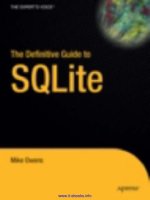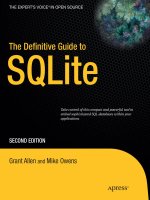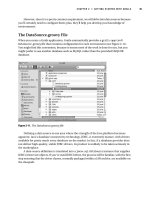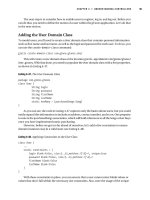The definitive guide to SQLite
Bạn đang xem bản rút gọn của tài liệu. Xem và tải ngay bản đầy đủ của tài liệu tại đây (5.77 MB, 369 trang )
Books for professionals By professionals
®
The Definitive Guide to SQLite
Dear Reader,
Outside of the world of enterprise computing there is one database that enables
a huge range of software and hardware to flex relational database capabilities,
without the baggage and cost of traditional database management systems.
That database is SQLite—an embeddable database with an amazingly small
footprint, yet it can handle databases of enormous size. SQLite comes equipped
with an array of powerful features available through a host of programming and
development environments. It is supported by languages such as C, Java, Perl,
PHP, Python, Ruby, TCL, and more.
The Definitive Guide to SQLite, 2nd Edition is devoted to complete cover-
age of the latest version of this powerful database. It offers a thorough over-
view of SQLite’s capabilities and APIs. The book also uses SQLite as the basis for
helping newcomers make their first foray into database development. In only
a short time you can be writing programs as diverse as a server-side browser
plug-in or the next great iPhone or Android application!
• You’ll learn about SQLite extensions for C, Java, Perl, PHP, Python, Ruby, and Tcl.
• You’ll get solid coverage of SQLite internals.
• You’ll explore developing iOS (iPhone) and Android applications with SQLite.
SQLite is the solution chosen for thousands of products around the world, from
mobile phones and GPS devices to set-top boxes and web browsers. You almost
certainly use SQLite every day without even realizing it!
Sincerely,
Grant Allen and Mike Owens
US $49.99
Shelve in:
Databases
User level:
Intermediate–Advanced
Mike Owens
THE APRESS ROADMAP
Beginning
Database Design
Beginning
SQL Queries
Applied Mathematics
for Database
Professionals
The Definitive Guide
to SQLite
www.apress.com
SOURCE CODE ONLINE
Companion eBook
See last page for details
on $10 eBook version
ISBN 978-1-4302-3225-4
9 781430 232254
54999
Allen
Owens
SECOND
EDITION
SQLite
Companion
eBook Available
The Definitive
Guide to
The eXperT’s Voice
®
in open source
SECOND EDITION
Grant Allen and Mike Owens
Take control of this compact and powerful tool to
embed sophisticated SQL databases within your
applications
The Definitive Guide to
SQLite
Grant Allen
The Definitive Guide
to SQLite
Second Edition
■ ■ ■
Grant Allen
Mike Owens
The Definitive Guide to SQLite, Second Edition
Copyright © 2010 by Grant Allen and Mike Owens
All rights reserved. No part of this work may be reproduced or transmitted in any form or by any means,
electronic or mechanical, including photocopying, recording, or by any information storage or retrieval
system, without the prior written permission of the copyright owner and the publisher.
ISBN-13 (pbk): 978-1-4302-3225-4
ISBN-13 (electronic): 978-1-4302-3226-1
Printed and bound in the United States of America 9 8 7 6 5 4 3 2 1
Trademarked names, logos, and images may appear in this book. Rather than use a trademark symbol
with every occurrence of a trademarked name, logo, or image we use the names, logos, and images only
in an editorial fashion and to the benefit of the trademark owner, with no intention of infringement of
the trademark.
The use in this publication of trade names, trademarks, service marks, and similar terms, even if they are
not identified as such, is not to be taken as an expression of opinion as to whether or not they are subject
to proprietary rights.
President and Publisher: Paul Manning
Lead Editor: Jonathan Gennick
Technical Reviewer: Richard Hipp
Editorial Board: Steve Anglin, Mark Beckner, Ewan Buckingham, Gary Cornell, Jonathan Gennick,
Jonathan Hassell, Michelle Lowman, Matthew Moodie, Duncan Parkes, Jeffrey Pepper,
Frank Pohlmann, Douglas Pundick, Ben Renow-Clarke, Dominic Shakeshaft, Matt Wade,
Tom Welsh
Coordinating Editor: Jennifer L. Blackwell
Copy Editor: Kim Wimpsett
Production Support: Patrick Cunningham
Indexer: Julie Grady
Artist: April Milne
Cover Designer: Anna Ishchenko
Distributed to the book trade worldwide by Springer Science+Business Media, LLC.,
233 Spring Street, 6th Floor, New York, NY 10013. Phone 1-800-SPRINGER, fax (201) 348-4505,
e-mail , or visit www.springeronline.com.
For information on translations, please e-mail , or visit www.apress.com.
Apress and friends of ED books may be purchased in bulk for academic, corporate, or promotional use.
eBook versions and licenses are also available for most titles. For more information, reference our
Special Bulk Sales–eBook Licensing web page at www.apress.com/info/bulksales.
The information in this book is distributed on an “as is” basis, without warranty. Although every
precaution has been taken in the preparation of this work, neither the author(s) nor Apress shall have
any liability to any person or entity with respect to any loss or damage caused or alleged to be caused
directly or indirectly by the information contained in this work.
The source code for this book is available to readers at www.apress.com.
To my mother for her endless support of all my crazy ideas
iv
Contents at a Glance
About the Authors xvi
About the Technical Reviewer xvii
Acknowledgments xviii
Introduction xix
■Chapter 1: Introducing SQLite 1
■Chapter 2: Getting Started 17
■Chapter 3: SQL for SQLite 47
■Chapter 4: Advanced SQL for SQLite 87
■Chapter 5: SQLite Design and Concepts 125
■Chapter 6: The Core C API 153
■Chapter 7: The Extension C API 195
■Chapter 8: Language Extensions 219
■Chapter 9: iOS Development with SQLite 253
■Chapter 10: Android Development with SQLite 279
■Chapter 11: SQLite Internals and New Features 303
Index 323
v
Contents
About the Authors xvi
About the Technical Reviewer xvii
Acknowledgments xviii
Introduction xix
■Chapter 1: Introducing SQLite 1
An Embedded Database 1
A Developer’s Database 2
An Administrator’s Database 3
SQLite History 3
Who Uses SQLite 4
Architecture 5
The Interface 6
The Compiler 6
The Virtual Machine 6
The Back End 7
Utilities and Test Code 8
SQLite’s Features and Philosophy 8
Zero Configuration 8
Portability 8
Compactness 9
■ CONTENTS
vi
Simplicity 9
Flexibility 9
Liberal Licensing 9
Reliability 10
Convenience 10
Performance and Limitations 11
Who Should Read This Book 13
How This Book Is Organized 14
Additional Information 15
Summary 15
■Chapter 2: Getting Started 17
Where to Get SQLite 17
SQLite on Windows 18
Getting the Command-Line Program 18
Getting the SQLite DLL 21
Compiling the SQLite Source Code on Windows 22
Building the SQLite DLL with Microsoft Visual C++ 25
Building a Dynamically Linked SQLite Client with Visual C++ 27
Building SQLite with MinGW 28
SQLite on Linux, Mac OS X, and Other POSIX Systems 30
Binaries and Packages 30
Compiling SQLite from Source 31
The Command-Line Program 32
The CLP in Shell Mode 33
The CLP in Command-Line Mode 34
■ CONTENTS
vii
Database Administration 35
Creating a Database 35
Getting Database Schema Information 37
Exporting Data 39
Importing Data 40
Formatting 40
Exporting Delimited Data 41
Performing Unattended Maintenance 41
Backing Up a Database 42
Getting Database File Information 44
Other SQLite Tools 45
Summary 46
■Chapter 3: SQL for SQLite 47
The Example Database 47
Installation 48
Running the Examples 49
Syntax 50
Commands 51
Literals 52
Keywords and Identifiers 53
Comments 53
Creating a Database 53
Creating Tables 53
Altering Tables 54
Querying the Database 55
Relational Operations 55
select and the Operational Pipeline 57
Filtering 59
■ CONTENTS
viii
Limiting and Ordering 64
Functions and Aggregates 66
Grouping 67
Removing Duplicates 72
Joining Tables 72
Names and Aliases 77
Subqueries 79
Compound Queries 81
Conditional Results 83
Handling Null in SQLite 84
Summary 86
■Chapter 4: Advanced SQL for SQLite 87
Modifying Data 87
Inserting Records 87
Updating Records 91
Deleting Records 92
Data Integrity 92
Entity Integrity 93
Domain Integrity 97
Storage Classes 101
Views 104
Indexes 106
Triggers 108
Transactions 111
Transaction Scopes 111
Conflict Resolution 112
Database Locks 115
Deadlocks 116
Transaction Types 117
■ CONTENTS
ix
Database Administration 118
Attaching Databases 118
Cleaning Databases 119
Database Configuration 120
The System Catalog 123
Viewing Query Plans 123
Summary 124
■Chapter 5: SQLite Design and Concepts 125
The API 125
The Principal Data Structures 126
The Core API 127
Operational Control 135
Using Threads 136
The Extension API 136
Creating User-Defined Functions 136
Creating User-Defined Aggregates 137
Creating User-Defined Collations 138
Transactions 138
Transaction Life Cycles 138
Lock States 139
Read Transactions 141
Write Transactions 141
Tuning the Page Cache 145
Transitioning to Exclusive 145
Sizing the Page Cache 145
Waiting for Locks 146
Using a Busy Handler 146
Using the Right Transaction 147
■ CONTENTS
x
Code . 149
Using Multiple Connections 149
The Importance of Finalizing . 150
Shared Cache Mode . 151
Summary 151
■Chapter 6: The Core C API 1 5 3
Wrapped Queries . 153
Connecting and Disconnecting . 153
The exec Query . 155
The Get Table Query . 159
Prepared Queries 1 6 1
Compilation . 161
Execution . 162
Finalization and Reset . 163
Fetching Records 164
Getting Column Information . 165
Getting Column Values . 166
A Practical Example . 168
Parameterized Queries . 169
Numbered Parameters . 172
Named Parameters . 173
Tcl Parameters . 173
Errors and the Unexpected . 174
Handling Errors . 174
Handling Busy Conditions . 176
Handling Schema Changes . 177
Download from Wow! eBook <www.wowebook.com>
■ CONTENTS
xi
Operational Control 178
Commit Hooks 178
Rollback Hooks 179
Update Hooks 179
Authorizer Functions 180
Threads 190
Shared Cache Mode 190
Threads and Memory Management 193
Summary 193
■Chapter 7: The Extension C API 195
The API 196
Registering Functions 196
The Step Function 198
Return Values 198
Functions 200
Return Values 202
Arrays and Cleanup Handlers 202
Error Conditions 203
Returning Input Values 203
Aggregates 204
Registration Function 205
A Practical Example 206
Collations 209
Collation Defined 210
A Simple Example 212
Collation on Demand 216
Summary 217
■ CONTENTS
xii
■Chapter 8: Language Extensions 219
Selecting an Extension 220
Perl 221
Installation 221
Connecting 222
Query Processing 222
Parameter Binding 224
User-Defined Functions 224
Aggregates 225
Python 226
Installation 226
Connecting 227
Query Processing 227
Parameter Binding 229
User-Defined Functions 230
Aggregates 231
APSW as an Alternative Python Interface 232
Ruby 232
Installation 232
Connecting 233
Query Processing 233
Parameter Binding 234
User-Defined Functions 236
Java 236
Installation 237
Connecting 238
Query Processing 238
User-Defined Functions and Aggregates 240
JDBC 241
■ CONTENTS
xiii
Tcl 243
Installation 243
Connecting 244
Query Processing 244
User-Defined Functions 247
PHP 247
Installation 248
Connections 248
Queries 248
User-Defined Functions and Aggregates 251
Summary 252
■Chapter 9: iOS Development with SQLite 253
Prerequisites for SQLite iOS Development 253
Signing Up for Apple Developer 254
Downloading and Installing Xcode and the iOS SDK 254
Alternatives to Xcode 258
Building the iSeinfeld iOS SQLite Application 259
Step 1: Creating a New Xcode Project 259
Step 2: Adding the SQLite Framework to Your Project 261
Step 3: Preparing the Foods Database 263
Step 4: Creating Classes for the Food Data 264
Step 5: Accessing and Querying the SQLite DB 269
Step 6: Final Polish and Wiring for iSeinfeld 272
iSeinfeld in Action! 272
Working with Large SQLite Databases Under iOS 276
Summary 277
■ CONTENTS
xiv
■Chapter 10: Android Development with SQLite 279
Prerequisites for SQLite Android Development 279
Check Prerequisites and the JDK 280
Downloading and Installing the Android SDK Starter Package 280
Downloading and Installing the Android Developer Tools 280
Adding Android Platforms and Components 281
The Android SQLite Classes and Interfaces 285
Using the Basic Helper Class, SQLiteOpenHelper 285
Working with the SQLiteDatabase Class 286
Applying SQLiteOpenHelper and SQLiteDatabase in Practice 290
Querying SQLite with SQLiteQueryBuilder 293
Building the Seinfeld Android SQLite Application 294
Creating a New Android Project 295
Adding the Seinfeld SQLite Database to Your Project 296
Querying the Foods Table 296
Defining the User Interface 297
Linking the Data and User Interface 298
Viewing the Finished Seinfeld Application 299
Care and Feeding for SQLite Android Applications 300
Database Backup for Android 300
Working with Large SQLite Databases Under Android 300
Summary 301
■Chapter 11: SQLite Internals and New Features 303
The B-Tree and Pager Modules 303
Database File Format 303
The B-Tree API 308
■ CONTENTS
xv
Manifest Typing, Storage Classes, and Affinity 311
Manifest Typing 311
Type Affinity 313
Affinities and Storage 314
Write Ahead Logging 318
How WAL Works 318
Activation and Configuration WAL 319
WAL Advantages and Disadvantages 320
Operational Issues with WAL-Enabled SQLite Databases 321
Summary 322
Index 323
xvi
About the Authors
■Grant Allen has worked in the IT field for more than 20 years, including
in roles such as chief technology officer at various leading software
development companies and such as data architect at Google. He has
worked across the industry, as well as in government and academia
around the world, consulting on large-scale systems design, development,
performance, innovation, and disruptive change. Grant is a frequent
speaker at conferences and industry events on topics such as data mining,
collaboration technologies, relational databases, and the business of
technology. In his spare time, Grant is completing a PhD in leading
disruptive innovation in high-technology companies.
■Mike Owens is the IT director for a major real estate firm in Fort Worth,
Texas, where he’s charged with the development and management of the
company’s core systems. His prior experience includes time spent at Oak
Ridge National Laboratory as a process design engineer, and at Nova
Information Systems as a C++ programmer. He is the original creator of
PySQLite, the Python extension for SQLite. Michael earned his bachelor’s
degree in chemical engineering from the University of Tennessee in
Knoxville.
Mike enjoys jogging, playing guitar, snow skiing, and hunting with his
buddies in the Texas panhandle. He lives with his wife, two daughters,
and two rat terriers in Fort Worth, Texas.
xvii
About the Technical Reviewer
■D. Richard Hipp is the creator and project leader for both SQLite and
the Fossil DVCS. Richard and his small yet select staff work full-time
maintaining and enhancing these products for an international
clientele.
Richard was born in Charlotte, North Carolina, where he currently
lives with his wife, Ginger. Richard holds degrees from Georgia Tech
(MSEE, 1984) and Duke University (PhD, 1992).
3
xviii
Acknowledgments
I'd like to express my gratitude to the entire team at Apress, especially Jonathan Gennick, my fabulous
editor, and Jennifer Blackwell, my wonderful project manager. They made it feel like the book was
almost writing itself! OK, that’s a lie, but really, they made the experience of producing The Definitive
Guide to SQLite an enjoyable and rewarding one.
I’d also like to pass on a huge thank you to D. Richard Hipp. Not only do we have Richard to thank
for the wonderful creation that is SQLite, but he also graciously offered to be my technical reviewer and
was gentle with his comments and criticisms. He taught me a great deal about the latest and greatest
features of SQLite, and I hope I’ve done him justice in bringing those topics to life in this book.
Lastly, a big thanks to all my friends and family, who put up with me writing yet another book, as
well as the crazy antics that go with it.
xix
Introduction
The Definitive Guide to SQLite covers SQLite in a comprehensive fashion, giving you the knowledge and
experience to use it in a wide range of situations. Whether you are a hard-core C developer, are a mobile
device aficionado, or are just seeking more know-how on the best embedded and small-footprint
database engine ever invented, this book it for you.
Prerequisites
This book assumes no prior knowledge of SQLite, though naturally people of all experience levels will
benefit from the material. SQLite is written in C with an extensive C API and also supports many other
languages such as Python, Tcl, Ruby, and Java. As a database engine, it also makes extensive use of SQL.
Although the examples in this book will benefit a reader of any skill level, we don’t have space to also
teach those languages.
How This Book Is Organized
The book contains 11 chapters, which cover the following broad areas:
• SQLite introduction, acquisition, and installation
• Using SQL with SQLite
• The C API for SQLite
• Using languages such as Python, Tcl, Ruby, and Java with SQLite
• Mobile device development with SQLite
• Internals and new features of SQLite
There’s no real impediment to jumping in to whatever area takes your fancy, though you may find
that Chapters 5, 6, and 7, which deal with the C API, are best approached in order.
Obtaining the Source Code of the Examples
The source code of all the examples in the book is available from the book’s catalog page on the Apress
web site, at Look for the “Source Code” link in the “Book
Resources” sidebar.
Download from Wow! eBook <www.wowebook.com>
C H A P T E R 1
■ ■ ■
1
Introducing SQLite
SQLite is an open source, embedded relational database. Originally released in 2000, it is designed to
provide a convenient way for applications to manage data without the overhead that often comes with
dedicated relational database management systems. SQLite has a well-deserved reputation for being
highly portable, easy to use, compact, efficient, and reliable.
An Embedded Database
SQLite is an embedded database. Rather than running independently as a stand-alone process, it
symbiotically coexists inside the application it serves—within its process space. Its code is intertwined,
or embedded, as part of the program that hosts it. To an outside observer, it would never be apparent
that such a program had a relational database management system (RDBMS) on board. The program
would just do its job and manage its data somehow, making no fanfare about how it went about doing
so. But inside, there is a complete, self-contained database engine at work.
One advantage of having a database server inside your program is that no network configuration or
administration is required. Take a moment to think about how liberating that is: no firewalls or address
resolution to worry about, and no time wasted on managing intricate permissions and privileges. Both
client and server run together in the same process. This reduces overhead related to network calls,
simplifies database administration, and makes it easier to deploy your application. Everything you need
is compiled right into your program.
Consider the processes found in Figure 1-1. One is a Perl script, another is a standard C/C++
program, and the last is an Apache-hosted PHP script, all using SQLite. The Perl script imports the
DBI::SQLite module, which in turn is linked to the SQLite C API, pulling in the SQLite library. The PHP
library works similarly, as does the C++ program. Ultimately, all three processes interface with the
SQLite C API. All three therefore have SQLite embedded in their process spaces. By doing so, not only
does each of those processes run their own respective code, but they’ve also become independent
database servers in and of themselves. Furthermore, even though each process represents an
independent server, they can still operate on the same database file(s) , benefitting from SQLite’s use of
the operating system to manage synchronization and locking.
Today there is a wide variety of relational database products on the market specifically designed for
embedded use—products such as Sybase SQL Anywhere, Oracle TimesTen and BerkleyDB, Pervasive
PSQL, and Microsoft’s Jet Engine. Some of the dominant commercial vendors have pared down their
large-scale databases to create embedded variants. Examples of these include IBM’s DB2 Everyplace,
Oracle’s Database Lite, and Microsoft’s SQL Server Express. The open source databases MySQL and
Firebird both offer embedded versions as well. Of all these products, only one is open source,
unencumbered by licensing fees, and designed exclusively for use as an embedded database: SQLite.
CHAPTER 1 ■ INTRODUCING SQLITE
2
Perl Code
SQLite
Perl Process
DBI::SQLite
SQLite C API
Operating System
Perl
C/C++
C/C++ App Process
DB
SQLite
SQLite C API
PHP Code
SQLite
Apache Process
PHP Data Objects
SQLite C API
PHP
Figure 1-1. SQLite embedded in host processes
A Developer’s Database
SQLite is quite versatile. It is a database, a programming library, and a command-line tool, as well an
excellent learning tool that provides a good introduction to relational databases. There are many ways to
use it—in embedded environments, websites, operating system services, scripts, and applications. For
programmers, SQLite is like “data duct tape,” providing an easy way to bind applications and their data.
Like duct tape, there is no end to its potential uses. In a web environment, SQLite can help with
managing complex session information. Rather than serializing session data into one big blob,
individual pieces can be selectively written to and read from individual session databases. SQLite also
serves as a good stand-in relational database for development and testing: there are no external RDBMSs
or networking to configure or usernames and passwords to hinder the programmer’s focus. SQLite can
also serve as a cache, hold configuration data, or, by leveraging its binary compatibility across platforms,
even work as an application file format.
Besides being just a storage receptacle, SQLite can serve as a purely functional tool for general data
processing. Depending on size and complexity, it may be easier to represent some application data
structures as a table or tables in an in-memory database. With so many developers, analysts, and others
familiar with relational databases and SQL, you can benefit from “assumed knowledge”—operating on
the data relationally by using SQLite to do the heavy lifting rather than having to write your own
algorithms to manipulate and sort data structures. If you are a programmer, imagine how much code it
would take to implement the following SQL statement in your program:
CHAPTER 1 ■ INTRODUCING SQLITE
3
SELECT x, STDDEV(w)
FROM table
GROUP BY x
HAVING x > MIN(z) OR x < MAX(y)
ORDER BY y DESC
LIMIT 10 OFFSET 3;
If you are already familiar with SQL, imagine coding the equivalent of a subquery, compound query,
GROUP BY clause, or multiway join in your favorite (or not so favorite) programming language. SQLite
embeds all of this functionality into your application with minimal cost. With a database engine
integrated directly into your code, you can begin to think of SQL as an offload engine in which to
implement complex sorting algorithms in your program. This approach becomes more appealing as the
size of your data set grows or as your algorithms become more complex. What’s more, SQLite can be
configured to use a fixed amount of RAM and then offload data to disk if it exceeds the specified limit.
This is even harder to do if you write your own algorithms. With SQLite, this feature is available with a
simple call to a single SQL command.
SQLite is also a great learning tool for programmers—a cornucopia for studying computer science
topics. From parser generators to tokenizers, virtual machines, B-tree algorithms, caching, program
architecture, and more, it is a fantastic vehicle for exploring many well-established computer science
concepts. Its modularity, small size, and simplicity make it easy to present each topic as an isolated case
study that any individual could easily follow.
An Administrator’s Database
SQLite is not just a programmer’s database. It is a useful tool for system administrators as well. It is
small, compact, and elegant like finely honed versatile utilities such as find, rsync, and grep. SQLite has
a command-line utility that can be used from the shell or command line and within shell scripts.
However, it works even better with a large variety of scripting languages such as Perl, Python, TCL, and
Ruby. Together the two can help with pretty much any task you can imagine, such as aggregating log file
data, monitoring disk quotas, or performing bandwidth accounting in shared networks. Furthermore,
since SQLite databases are ordinary disk files, they are easy to work with, transport, and back up.
SQLite is a convenient learning tool for administrators looking to learn more about relational
databases. It is an ideal beginner’s database with which to learn about relational concepts and practice
their implementation. It can be installed quickly and easily on any platform you’re likely to encounter,
and its database files share freely between them without the need for conversion. It is full featured but
not daunting. And SQLite—both the program and the database—can be carried around on a USB stick or
memory chip.
SQLite History
SQLite was conceived on a battleship well, sort of. SQLite’s author, D. Richard Hipp, was working for
General Dynamics on a program for the U.S. Navy developing software for use on board guided missile
destroyers. The program originally ran on Hewlett-Packard Unix (HP-UX) and used an Informix
database as the back end. For their particular application, Informix was somewhat overkill. For an
experienced database administrator (DBA) at the time, it could take almost an entire day to install or
upgrade. To the uninitiated application programmer, it might take forever. What was really needed was
a self-contained database that was easy to use and that could travel with the program and run anywhere
regardless of what other software was or wasn’t installed on the system.









